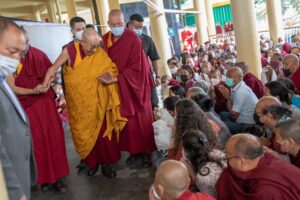 His Holiness the Dalai Lama gave a two-day teaching on Chandrakirti’s Entering the Middle Way at the request of a group of Southeast Asians at Tsuglakhang, the main temple in Dharamsala on September 15 and 16 to an audience of over 6,000 people from 57 countries, including 650 Buddhists from Singapore, Malaysia, Indonesia, Thailand and Vietnam.
His Holiness the Dalai Lama gave a two-day teaching on Chandrakirti’s Entering the Middle Way at the request of a group of Southeast Asians at Tsuglakhang, the main temple in Dharamsala on September 15 and 16 to an audience of over 6,000 people from 57 countries, including 650 Buddhists from Singapore, Malaysia, Indonesia, Thailand and Vietnam.
His Holiness started the teaching by reciting “I prostrate to Gautama who, through compassion, taught the exalted Dharma, which leads to the relinquishing of all (distorted) views,” the final verse of homage from Nagarjuna’s Fundamental Wisdom of the Middle Way. “Since we suffer because of ignorance, we have to eliminate all distorted views and develop the correct view. If we are to do this, we need to study, reflect on what we’ve learned and meditate on what we’ve understood,” said His Holiness. “When I first heard about emptiness, I felt it was good, but it was only after I had studied Fundamental Wisdom, Entering into the Middle Way and its auto-commentary, and thought deeply about it, that I gained conviction,” he continued.
His Holiness explained that distorted views cannot be dispelled by saying mantras but by studying and developing understanding of texts, including Ornament for Clear Realisation and Entering into the Middle Way. He said that the Ornament teaches mostly the Bodhisattva paths and grounds, the method aspect of the path. Entering into the Middle Way reveals the wisdom understanding emptiness.
The Tibetan spiritual leader also stressed that as human beings we have the opportunity to study the Dharma, and to understand and experience, it citing his own personal experience, “when I was young, I memorised important texts, listened to my tutors’ explanations of them and thought about them deeply. In exile, I was able to really reflect on what I’d learned, so, from that point of view, coming into exile was like a blessing in disguise. It’s through study, reflection and meditation that transformation takes place.”
 Explaining Entering into the Middle Way and its auto-commentary, His Holiness said that Chandrakirti, the author, pays homage to great compassion, alluding to the fact that Buddha became enlightened through a combination of the awakening mind of bodhichitta, which is rooted in compassion, and an insight into emptiness.
Explaining Entering into the Middle Way and its auto-commentary, His Holiness said that Chandrakirti, the author, pays homage to great compassion, alluding to the fact that Buddha became enlightened through a combination of the awakening mind of bodhichitta, which is rooted in compassion, and an insight into emptiness.
His Holiness reiterated the importance of cultivating love and compassion and shared his plans to discuss with educationists ways in which to restore an admiration for love and compassion in the educational system.
“If you check who you are, your body is not you. Your mind is not you, and yet you have a strong sense of cherishing yourself. Think about how, whether you are going somewhere or simply resting, you cannot pin-point a self in connection with your body or mind. Consequently, you may conclude that the idea of a self is merely designated on the collection of psycho-physical aggregates” said His Holiness.
On the second day of the teaching, speaking about suffering and its causes, His Holiness said, “we need to understand the nature and extent of suffering. Something may appear to be pleasurable, but is actually of the nature of suffering. Suffering and dissatisfaction are not outside us, they’re something we experience within. However, we can achieve their cessation by cultivating the path that consists of the Three Higher Trainings—ethics, concentration and wisdom”.
His Holiness answered questions from the audiences before concluding the teaching.




 Print
Print Email
Email